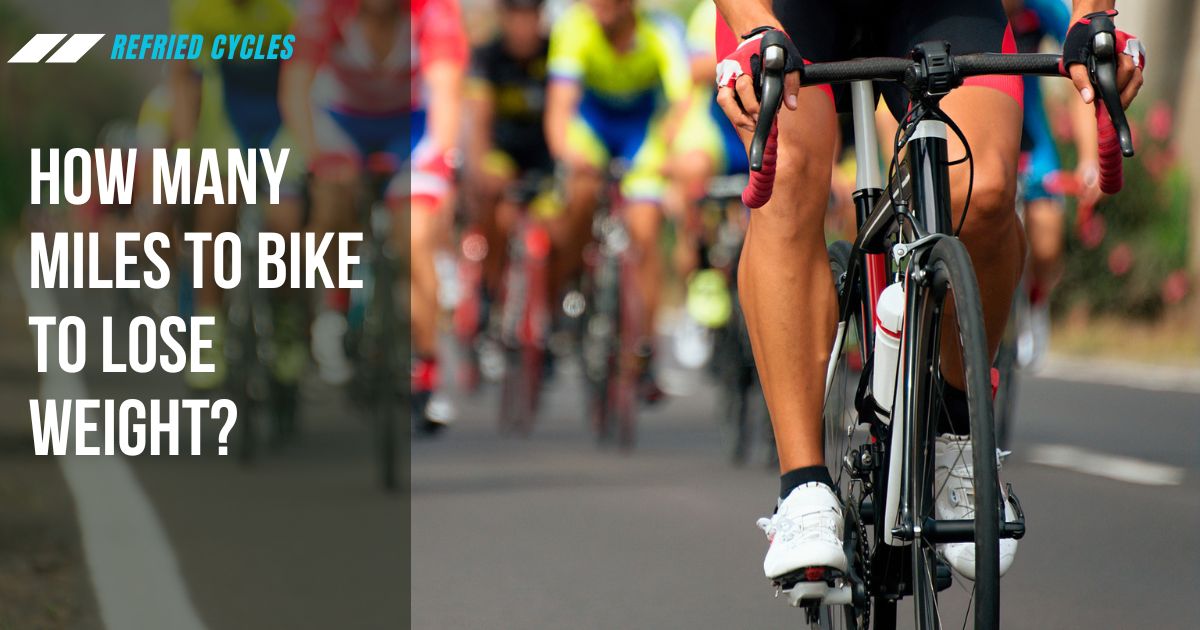Welcome to your comprehensive guide on “How Many Miles to Bike to Lose Weight”! Embarking on a journey to shed pounds can be both exhilarating and daunting. Cycling, a fantastic way to improve fitness and lose weight, has gained immense popularity for its effectiveness and enjoyment. But the burning question remains: how many miles should you bike to achieve significant weight loss? This guide is tailored to help you understand the intricate relationship between cycling and weight loss, factoring in elements like your starting weight, fitness level, and more. So, grab your helmet and water bottle, and let’s pedal through this journey together.
Factors Influencing Weight Loss through Cycling
Understanding the factors that influence weight loss while cycling is super important in setting real goals and maximizing your efforts. Your journey on two wheels is impacted by several key elements:
- Starting Weight and Fitness Level: Heavier individuals burn more calories per mile, and your fitness level dictates how efficiently your body uses energy.
- Intensity of Your Rides: Opting for high-intensity rides or challenging terrains like hills increases calorie burn.
- Duration of Your Rides: Longer rides lead to more calories burned, but consistency is vital. Regular rides throughout the week are super important for sustainable weight loss.
- Calorie Intake: A balanced diet, in conjunction with cycling, ensures a calorie deficit, which is imperative for weight loss.
- Individual Factors: Factors such as age, gender, and overall health influence how your body burns calories and loses weight.
Starting Weight and Fitness Level
Your starting weight and current fitness level play a significant role in your cycling and weight loss journey. Individuals with a higher starting weight tend to burn more calories per mile because their bodies require more energy to move. On the other hand, those who are fitter usually have a more efficient metabolism and, as a result, may burn fewer calories for the same distance. Understanding this can help you set real goals and track your progress effectively.
For beginners, it’s super important to start at a comfortable pace and gradually increase the intensity and duration of your rides. This approach helps in building endurance and prevents potential injuries. On the other hand, seasoned cyclists can focus on more challenging routes and longer distances to continue pushing their limits.
Intensity of Your Rides
The intensity of your cycling sessions significantly impacts the number of calories you burn. High-intensity rides, such as tackling hills or incorporating sprints, can drastically increase your calorie expenditure compared to leisurely rides. This is due to the higher demand placed on your muscles and cardiovascular system.
Choosing varied terrains and incorporating different cycling styles, like interval training, can enhance your weight loss efforts. For instance, alternating between periods of intense cycling and lower intensity can boost your metabolism and improve your endurance.
Furthermore, riding at different times of the day, like early mornings or evenings, can also affect your performance and calorie burn. It’s super important to find a routine that suits your lifestyle and keeps you motivated.
Duration of Your Rides
The length of your cycling sessions is a critical factor in determining how many calories you burn. Longer rides naturally lead to a higher calorie burn, but it’s super important to balance duration with intensity for effective weight loss.
Consistency is key in your cycling routine. Aiming for regular rides throughout the week, rather than one long ride, helps maintain a consistent calorie deficit and supports sustained weight loss. Gradually increasing the duration of your rides as your fitness improves will also help in burning more calories and building endurance.
It’s also important to listen to your body and avoid overtraining. Rest days are super important for muscle recovery and overall health. Balancing cycling with other forms of exercise can also provide a well-rounded fitness regime.
Calorie Intake
Weight loss is fundamentally about creating a calorie deficit – burning more calories than you consume. While cycling is an excellent way to increase calorie expenditure, it’s equally important to pay attention to your diet.
Adjusting your calorie intake to reflect your increased physical activity is super important. This doesn’t necessarily mean eating less; rather, it involves choosing healthier, more nutritious options that fuel your rides and aid recovery. Incorporating a mix of proteins, carbohydrates, and healthy fats into your diet is super important for sustained energy and muscle repair.
It’s also vital to stay hydrated, especially on longer rides. Water aids in metabolism and helps prevent fatigue. Consuming small, balanced meals or snacks before and after your rides can also maximize your performance and recovery.
Individual Factors: Age, Gender, and Overall Health
Age, gender, and overall health are significant individual factors that affect how your body responds to cycling and weight loss. These factors influence your metabolism, calorie-burning capability, and how your body recovers after exercise.
- Age: As we age, our metabolism naturally slows down, which can affect how quickly we lose weight. Older cyclists might need to incorporate additional strength training or adjust their diet to see the same results as younger riders.
- Gender: Men and women burn calories differently due to hormonal and physiological differences. Generally, men have a higher muscle mass, which can lead to a more significant calorie burn.
- Overall Health: Existing health conditions, such as thyroid issues or diabetes, can impact weight loss. It’s super important to consult with a healthcare professional to tailor your cycling and diet plan according to your health needs.
Understanding these individual factors helps in setting real goals and adopting a cycling routine that aligns with your unique body requirements.
How Many Miles Do You Need to Bike to Lose Weight?
When it comes to cycling for weight loss, the magic number of miles isn’t one-size-fits-all. Instead, it varies based on several individual factors. Let’s break these down to understand how you can tailor your cycling routine for effective weight loss.
- Your Weight and Body Composition: A super important factor is your current weight and body composition. Heavier individuals burn more calories per mile due to the greater effort required to move their body. Additionally, muscle mass plays a significant role. The more muscle you have, the higher your resting metabolic rate, meaning you’ll burn more calories even when you’re not cycling.
- Intensity of Your Ride: The harder your body works during cycling, the more calories you burn. Riding at a moderate pace (about 12-14 mph) will burn more calories than a leisurely ride. Challenging yourself with uphill rides or rough terrains can also significantly increase calorie expenditure compared to flat, smooth routes.
- Duration of Your Ride: Longer rides equal more calories burned. However, it’s super important to balance duration with your body’s capabilities. Overtraining can lead to fatigue and injury, so listen to your body’s signals.
- Overall Calorie Intake: Weight loss ultimately boils down to creating a calorie deficit – burning more calories than you consume. Your diet plays a vital role in this equation.
General Guidelines for Cycling to Lose Weight
To put these factors into practical terms, consider these guidelines:
- For Weight Loss (1-2 pounds per week): Aim for about 84-98 miles per week at a moderate pace. This translates to roughly 12-14 miles per day.
- For Weight Maintenance: Aiming for 60-70 miles per week at a moderate pace is a good target.
- To Improve Fitness: Those looking to enhance their fitness levels might aim for 100 miles or more per week.
Starting slowly and gradually increasing both mileage and intensity is key. This approach helps prevent injuries and burnout, making your cycling journey both enjoyable and sustainable.
Realistic Goals for Casual Cyclists
If 84-98 miles per week seems daunting, especially for casual cyclists, there’s no need to worry. Setting a more achievable goal of 5 miles per day is a great starting point. This lower mileage still contributes to weight loss, especially when combined with a balanced diet and overall active lifestyle.
Remember, the journey to weight loss is personal and varies from one cyclist to another. It’s about finding a balance that works for you, your body, and your lifestyle. Whether it’s 5 miles a day or 100 miles per week, each mile cycled is a step closer to your weight loss goals.
Tips for Maximizing Weight Loss through Cycling
To maximize your weight loss through cycling, consider these additional tips:
- Warm-Up and Cool Down: Properly warming up before and cooling down after each ride helps prevent injuries and improve your performance.
- Interval Training: Incorporate interval training into your rides. Alternating between high and low intensities increases calorie burn and improves endurance.
- Ride with Friends or Join a Group: Cycling with others can boost motivation and make your rides more enjoyable.
- Track Progress: Use a fitness tracker or app to monitor your rides, distance, and calories burned. This data can be motivating and help in setting future goals.
- Healthy Nutrition: Fuel your body with nutritious meals and snacks. Eating well supports your energy needs and recovery after rides.
- Stay Hydrated: Regular hydration is super important, especially on longer rides, to maintain performance and aid recovery.
- Seek Professional Advice: Consulting a certified trainer or nutritionist can provide personalized guidance and help you achieve your goals more effectively.
Cycling is not just a means to lose weight; it’s a journey towards a healthier, more active lifestyle. The miles you need to bike to lose weight depend on various individual factors, but aiming for 30-100+ miles per week, according to your fitness level, can significantly impact your weight loss journey. Remember, consistency and a balanced approach combining exercise, nutrition, and rest are vital for sustainable results.
As you continue to pedal towards your fitness goals, consider exploring more resources and cycling tips at Refried Cycles Refried Cycles. This destination offers a wealth of information to support your cycling adventure, helping you become a fitter, healthier version of yourself.
Embark on this exciting journey with your bike, embrace the challenge, and enjoy the ride towards a healthier you!









